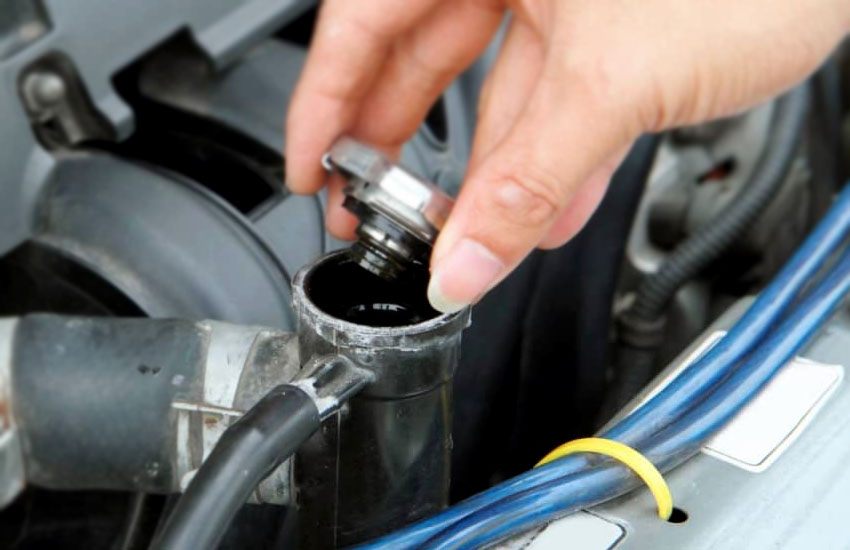As an Amazon Associate, I earn from qualifying purchases at no extra cost to you.
How to Tell If Your Radiator Cap is Bad: A Simple, In-Depth Guide
If you’re having car troubles, the radiator cap could be the culprit. It's easy to overlook, but a bad radiator cap can cause your engine to overheat, damage other parts, and lead to costly repairs. In this guide, we'll walk you through how to tell if your radiator cap is bad and what you can do about it. Whether you’re a car expert or just someone who wants to keep their vehicle running smoothly, this guide is for you. Let's dive in!

What Does a Radiator Cap Do?
Before we dive into how to tell if your radiator cap is bad, let's take a moment to understand its role in your car's cooling system. The radiator cap might look small and insignificant, but it actually plays a big part in keeping your engine cool and running smoothly.
Keeps Pressure in Check
The radiator cap helps maintain the correct pressure in the cooling system. It keeps the system from getting too much pressure or losing too much, which is essential for keeping your engine cool.
Prevents Coolant Loss
The radiator cap is also designed to seal the cooling system tightly. If there's any crack or gap in the seal, it could allow coolant to leak out, which can lead to your engine overheating.
Allows Coolant Flow
When your engine gets too hot, the radiator cap opens to let extra coolant flow into the radiator. It also allows the coolant to move between the engine and the radiator, helping to regulate the engine's temperature.
Helps with Boiling Point
By maintaining the right pressure, the radiator cap helps raise the boiling point of the coolant. This means your engine can run hotter without overheating.
In short, the radiator cap is a small but important part of your car's cooling system. If it's bad, it can lead to overheating and other serious issues. Let's talk about how to tell if it's time for a new one.
Common Signs of a Bad Radiator Cap
If your radiator cap is faulty, it can cause several problems. Some of the signs are easy to spot, while others might take a little more time to notice. Here are some of the most common signs that your radiator cap might be bad.
Overheating Engine
One of the first signs of a bad radiator cap is an overheating engine. If the radiator cap isn't able to hold the proper pressure, the coolant may not flow correctly through the system. This can lead to your engine running too hot, which is a major issue that can cause serious damage.
You might notice the temperature gauge on your dashboard rising higher than normal. If your car starts to overheat, you should pull over as soon as it's safe to do so and check the radiator cap. If it's not tight or seems damaged, it could be time for a replacement.
Coolant Leaks
Another sign of a bad radiator cap is coolant leaking from the system. If the cap is cracked or damaged, it can allow coolant to escape, which will cause a drop in coolant levels. If you notice puddles of coolant under your car or low coolant levels, the radiator cap could be the problem.
Coolant leaks can happen because the cap isn't sealing properly. This leads to coolant spilling out, which leaves you with less coolant to cool the engine. Without enough coolant, your engine can overheat.
Collapsing Hoses
If your radiator cap is bad, you may also notice that your hoses are collapsing. When the radiator cap isn't maintaining the right pressure, the vacuum created in the system can cause the hoses to collapse. This is a sign that the cap is no longer functioning properly.
Collapsed hoses may not be easy to spot at first, but you can usually feel them by squeezing the hoses when the engine is off and cool. If the hoses feel unusually soft or flat, it could mean there's a problem with the radiator cap.
Air in the Cooling System
A faulty radiator cap can also allow air to enter the cooling system. This can lead to air pockets, which can cause your engine to overheat or run inefficiently. You may notice that your car is having trouble staying cool, or the heater may not be blowing warm air.
If there's air in the system, you might also hear gurgling sounds coming from the radiator or hoses. This is a sign that air is trapped in the cooling system, and it can lead to further issues if not addressed.
Visible Damage to the Cap
In some cases, the radiator cap itself might show signs of visible damage. If you see cracks, chips, or corrosion on the cap, it's definitely time to replace it. A damaged cap can't do its job properly, and it could lead to the issues mentioned above.
You should inspect your radiator cap regularly, especially if you’re experiencing any of the signs listed above. A small crack might not seem like a big deal, but it can cause significant problems over time.
How to Test and Replace a Radiator Cap
If you suspect that your radiator cap is bad, it's important to test it before making a decision about replacing it. Here are some steps you can take to test the radiator cap and make sure it's functioning properly.
Use a Pressure Tester
A pressure tester is the best way to check the condition of your radiator cap. You can buy one from an auto parts store or borrow one from a friend. A pressure tester works by simulating the pressure inside your radiator system to see if the cap holds the pressure.
Here's how to use a pressure tester:
- First, make sure the engine is off and cool.
- Remove the radiator cap and attach the pressure tester to the radiator opening.
- Pump the tester to increase pressure in the system. If the cap holds pressure and doesn't let coolant leak, it's likely in good condition.
- If the pressure drops or coolant starts to leak, the cap is bad and should be replaced.
Visual Inspection
If you don't have a pressure tester, you can do a visual inspection of the radiator cap. Look for any cracks, chips, or signs of wear and tear. If you see any damage, it's time to replace the cap.
Also, check the rubber gasket on the inside of the cap. If it's cracked or damaged, the cap won't create a proper seal, and you'll need to replace it.
Replacing the Radiator Cap
Replacing the radiator cap is a simple process, but it's important to do it correctly to avoid further damage. Here's a step-by-step guide to replacing the radiator cap:
- Step 1: Turn off the engine and let it cool. Never remove the radiator cap while the engine is hot, as this can cause serious burns.
- Step 2: Open the hood and locate the radiator cap. It should be easy to find, as it's usually at the top of the radiator.
- Step 3: Twist the cap counterclockwise to remove it from the radiator. Be gentle and don't force it if it's stuck.
- Step 4: Compare the old cap with the new one to make sure they're the same size and type. There are different kinds of radiator caps, so make sure you buy the correct one for your vehicle.
- Step 5: Place the new cap onto the radiator and twist it clockwise to secure it. Make sure it's tightly sealed.
- Step 6: Start the engine and check for leaks or any unusual noises. If everything seems fine, you're good to go!
Replacing the radiator cap is a quick and easy fix that can prevent bigger problems down the road. It's an inexpensive part, so it's worth replacing it if you're having issues with overheating or coolant leaks.
I hope this article helped you understand how to tell if your radiator cap is bad. If you’re noticing any signs of trouble, like overheating or leaks, it might be time to replace the radiator cap. Taking care of small problems early can save you big headaches later on.
Frequently Asked Questions
Is it safe to drive with a bad radiator cap?
Driving with a bad radiator cap is not safe. If the radiator cap isn't functioning properly, it can cause your engine to overheat. Overheating can lead to severe engine damage, such as warped cylinder heads, blown gaskets, or cracked engine blocks. In addition, a bad cap can cause coolant leaks, leaving your engine without enough coolant to regulate temperature. This can result in engine failure. It's best to address the issue immediately by replacing the radiator cap to avoid costly repairs and ensure your vehicle stays safe and reliable.
Can a bad radiator cap cause the car to overheat?
Yes, a bad radiator cap can cause your car to overheat. The radiator cap maintains the pressure in the cooling system, which helps regulate the coolant's temperature. If the cap is damaged or faulty, it can't hold the pressure, causing the coolant to lose its effectiveness. This results in the engine running hotter than it should. If left unchecked, this can lead to engine overheating, which can cause severe damage to the engine. Replacing a bad radiator cap can help prevent overheating and keep your engine running smoothly.
Do I need to replace the radiator cap if it's leaking?
Yes, if your radiator cap is leaking, it needs to be replaced. A leaking cap means that the seal isn't working properly, which can lead to coolant escaping from the system. Without enough coolant, your engine won't be able to stay cool, leading to overheating and potential engine damage. If you notice coolant leaking from the cap or puddles under your car, it's important to replace the radiator cap as soon as possible to avoid further issues with the cooling system.
Is it easy to replace a radiator cap on my own?
Replacing a radiator cap is easy and can be done at home with basic tools. All you need to do is turn off the engine and let it cool. Then, remove the old radiator cap, inspect it for damage, and install a new one by twisting it into place. It's important to ensure that the cap is the right size and type for your car, and make sure it is securely in place. If you’re unsure about any step, there are plenty of online tutorials that can guide you through the process.
Can a bad radiator cap cause the heater to stop working?
Yes, a bad radiator cap can cause the heater to stop working. If the cap isn't maintaining the correct pressure in the cooling system, air can enter the system, leading to air pockets in the coolant. This can prevent the coolant from circulating properly and affect the heater's ability to blow warm air. If you notice your car's heater is blowing cold air or not working at all, it could be a sign that your radiator cap is bad and needs to be replaced.
Is it worth replacing a bad radiator cap yourself?
Replacing a bad radiator cap yourself is worth it because it's a simple and inexpensive repair. The radiator cap is a small part that can save you from more serious issues like overheating or coolant leaks, which can lead to expensive engine repairs. By replacing the cap yourself, you can avoid paying for labor costs at a mechanic's shop. It's a quick fix that can be done with basic tools, and it's a great way to keep your car running smoothly.
Can a bad radiator cap cause engine damage?
Yes, a bad radiator cap can cause engine damage. If the cap isn't sealing properly, it can lead to a loss of coolant, which can cause the engine to overheat. Overheating can lead to serious damage, such as warped cylinder heads, blown gaskets, or cracked engine blocks. These types of engine problems can be very costly to fix. By replacing the radiator cap when you first notice any signs of trouble, you can avoid these serious issues and keep your engine in good condition.
Do I need to replace my radiator cap regularly?
While radiator caps don't need to be replaced frequently, it's a good idea to check them regularly for signs of damage. Most radiator caps can last for many years, but over time, the rubber gasket inside the cap can wear out or crack, leading to leaks or loss of pressure. It's a good idea to replace your radiator cap if you notice any signs of wear or if your car is overheating or leaking coolant. Regular inspection and replacement can help you avoid bigger problems with the cooling system.











